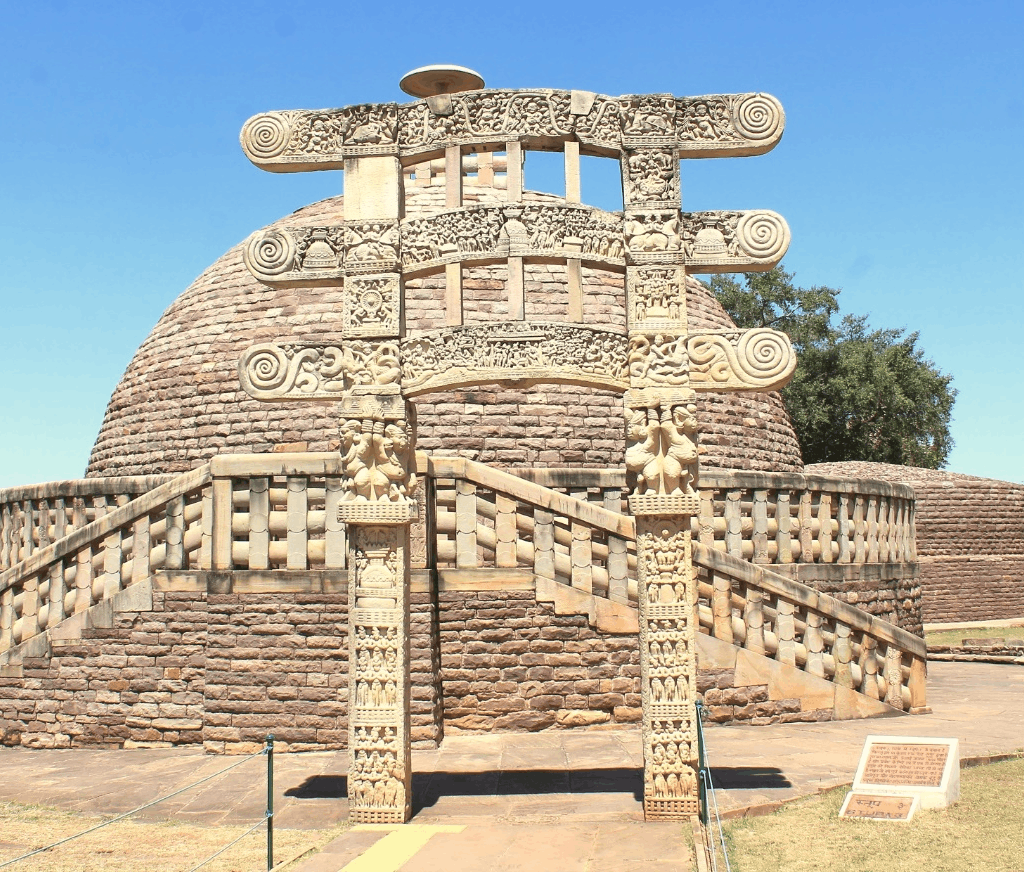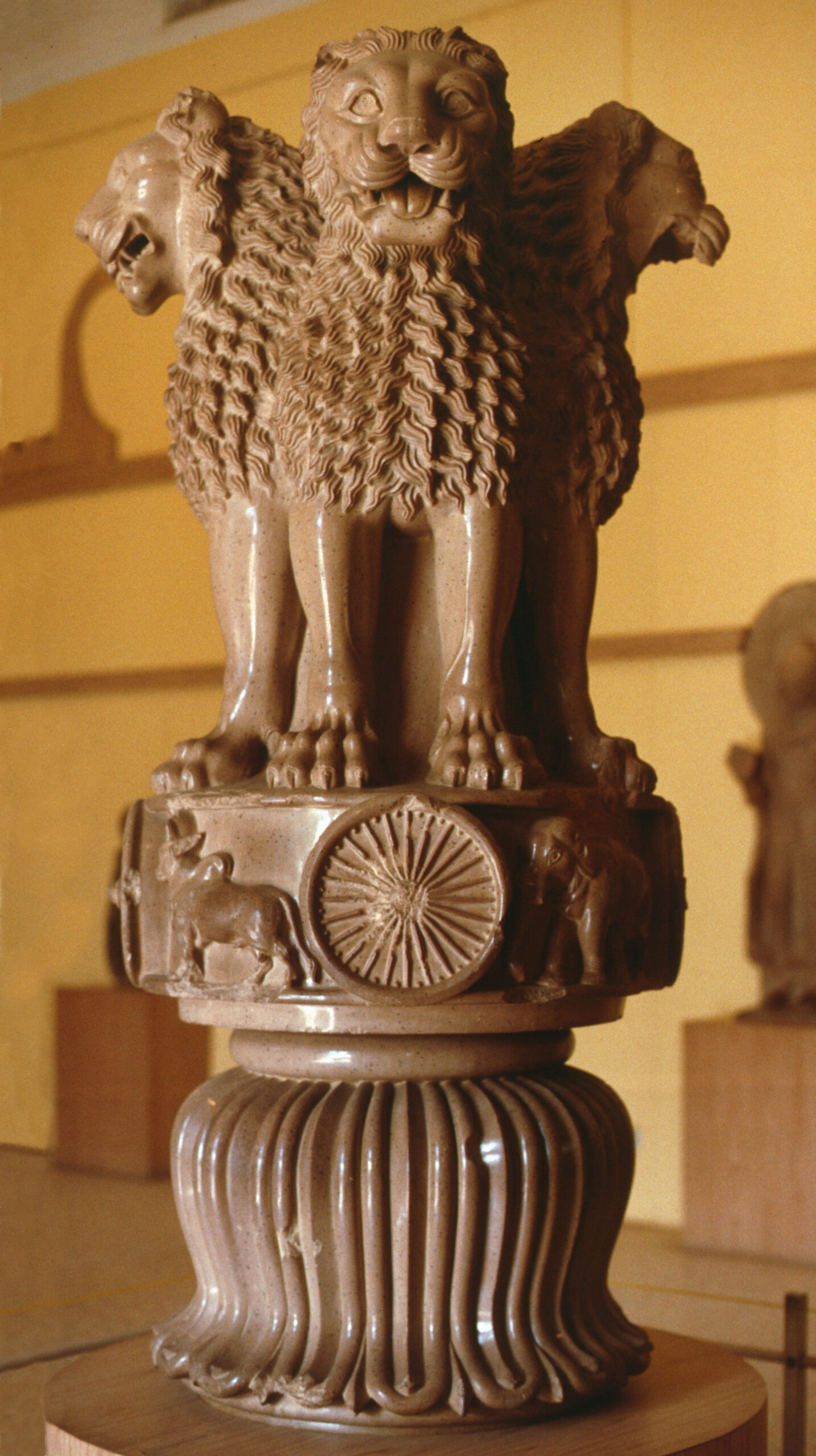
(3rd century B.C. to 8th century A.D.)
Maurya art encompasses the art produced during the period of king Ashoka. he was the first emperor to rule over most of the Indian subcontinent. Indian art had undergone an important transition during his period as his stone came into use in place of wood. The royal art was patronized by him. he built pillars stupas and caves.
The elaborately carved animal on Ashoka pillar are the best-known works and among the finest is the lion capital of Ashoka from sarnath, as it is now the national emblem of India. Mauryan art had both court and popular art. court art is represented by the pillars and their capital. Popular rt is represented by its works of the local sculptors like (Chauri) whisk – bearer from Didar Ganj.
These pillars were carved in two type of stones some were of the spotted red and white sandstone from the region of Mathura , the others were of buff colored fine grained hard sandstone usually with small black spots quarried in chunar near Varanasi. The uniformity of the style in the pillar capital suggests that they all were sculpted by craftsman from the same region .they were given a fine polish characteristic of Mauryan sculpture .these pillars were mainly erected in the gangetic plains . they were inscribed withn edicts of Ashoka on dhamma or righteousness.
Evolution of Art in Ancient India: Mauryan, Shunga, Kushan, Gandhara, Mathura, and Gupta Periods
Indian art has a rich and diverse history that spans several millennia. From the ancient times, art in India has reflected the cultural, social, and religious beliefs of the various dynasties that ruled over the subcontinent. In this article, we will delve into the artistic styles and contributions of the Mauryan, Shunga, Kushan, Gandhara, Mathura, and Gupta periods, which played a significant role in shaping the artistic landscape of ancient India.
- Mauryan Art (322 BCE – 185 BCE):
The Mauryan Empire, under the reign of Emperor Ashoka, witnessed a remarkable development in art and architecture. Mauryan art is known for its monumental stone sculptures, mainly in the form of pillars and rock-cut caves. The Ashokan pillars, such as the famous Lion Capital at Sarnath, symbolize the pillars of dharma (righteousness) and bear edicts and inscriptions. Mauryan art also manifested in the creation of polished stone sculptures, often depicting Yakshas, Yakshis, and various other deities. - Shunga Art (185 BCE – 73 BCE):
After the decline of the Mauryan Empire, the Shunga dynasty emerged and made significant contributions to art. Shunga art retained the traditional Mauryan forms but showed stylistic changes. Sculptures and stupa railings from the Shunga period often displayed a graceful and linear quality. The Bharhut Stupa is an iconic example of Shunga art, featuring intricate relief sculptures narrating stories from the life of the Buddha. - Kushan Art (1st century CE – 3rd century CE):
The Kushan Empire, which encompassed present-day Afghanistan, Pakistan, and northern India, was a melting pot of cultural influences. Kushan art reflects a fusion of Indian, Greek, Persian, and Central Asian styles. The Gandhara region, under Kushan patronage, became a significant center of Buddhist art. Gandhara art is characterized by realistic and idealized representations of the Buddha and bodhisattvas, with Greco-Roman influences seen in the drapery and facial features. - Gandhara Art (1st century CE – 5th century CE):
The Gandhara region, situated in present-day Pakistan and Afghanistan, flourished as a center of Buddhist art during the Kushan period. Gandhara art evolved under the influence of Hellenistic and Roman artistic traditions brought by the Greeks who settled in the region after Alexander the Great’s conquest. Gandhara sculptures are known for their blending of Indian and classical Western styles, with intricate carvings, realistic human figures, and elaborate drapery. - Mathura Art (1st century CE – 6th century CE):
Located in present-day Uttar Pradesh, Mathura became a significant center of art during the Kushan and Gupta periods. Mathura art predominantly focused on Hindu themes, with sculptures depicting various gods and goddesses like Vishnu, Shiva, and Devi. Mathura sculptures exhibit dynamic and sensual forms, emphasizing the portrayal of divinity in human form. These sculptures often showcase elaborate hairstyles, jewelry, and richly adorned clothing. - Gupta Art (4th century CE – 6th century CE):
The Gupta period is considered the golden age of Indian art and witnessed remarkable achievements in architecture, sculpture, and painting. Gupta art embraced a more idealized and spiritual style, characterized by grace, serenity, and balance. The temples of Deogarh and the iconic rock-cut caves of Ajanta and Ellora exemplify Gupta architecture and sculpture. Gupta period paintings, as seen in the Ajanta caves, display vibrant colors, intricate detailing, and exquisite storytelling.
The artistic traditions of ancient India, as showcased in the Mauryan, Shunga, Kushan, Gandhara, Mathura, and Gupta periods, bear testimony to the remarkable creativity and cultural amalgamation of the time. These periods not only laid the foundation for subsequent artistic styles in India but also left an indelible mark on the artistic heritage of the world. The diverse range of artistic expressions from this era continues to inspire and captivate art enthusiasts even today, offering a glimpse into the rich tapestry of ancient Indian civilization.
